Material:? Aluminum alloy
Torque range: 50-6000NM
Size:? 50NM 80NM 100NM 150NM 200NM 300NM 500NM 600NM 800NM 1200NM 1500NM 2000NM 3000NM 4000NM 5000NM 6000NM
Valve application:? Butterfly valve, ball valve
Travel range: 0-90°
Voltage: 220VAC, 380VAC, 440VAC,110VAC,24VDC,110VDC,220VDC
Control signal: 4-20mA, 0-10v, 1-5v

The post ATEX electric actuators appeared first on Control Valve Manufacturers?.
]]>With compatibility for industry-standard valves like electric valve actuators, electric actuated ball valves, and electric actuated butterfly valves, these actuators offer superior flexibility and dependability for critical industrial applications. Integrated support for control signals including 4-20mA, 0-10v, and 1-5v
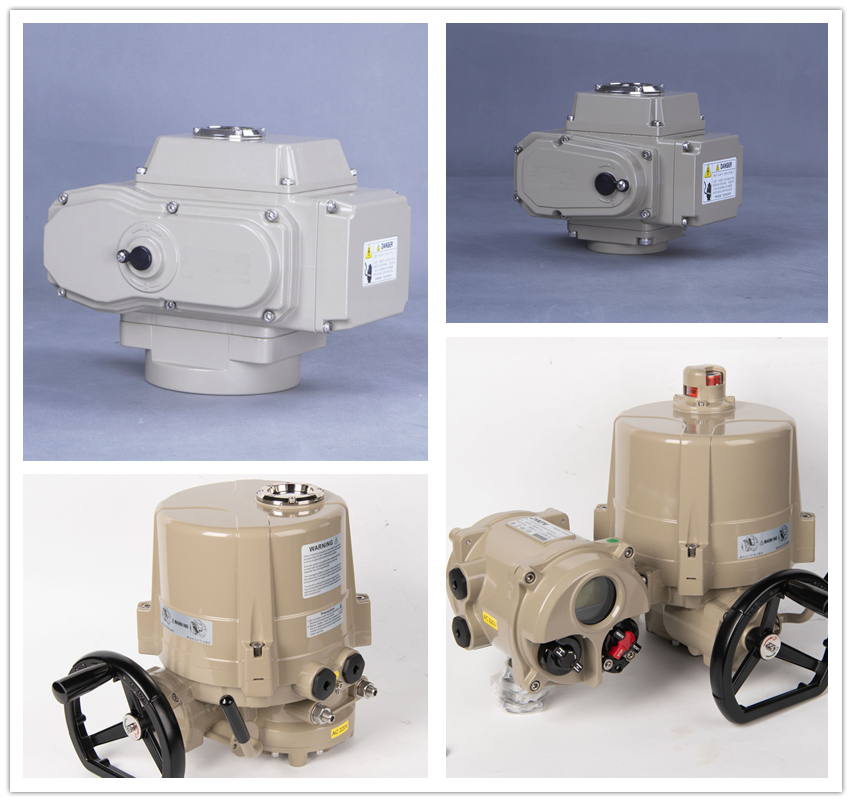
- Exceptional Torque Range: Offering a torque range of 50~6000N.m, these actuators deliver the power and adaptability needed to meet the unique demands of diverse applications.
- Dynamic Switching Time: Achieve rapid and efficient performance with switching times ranging from 22~185 seconds, ensuring precise and responsive valve control.
- Advanced Control Methods: Enjoy unmatched flexibility with control options including On and off, Modulating type, and
- Intelligent type, allowing you to adapt to the demands of varying industrial processes.
- Lightweight Design: With a weight range of 7.5 KG to 83 KG, these actuators are easy to transport, install, and integrate, minimizing strain on your system.
- Superior Protection: Built with IP67-rated protection as standard, the actuators perform reliably in harsh environments. For increased protection, optional IP68 and ExdⅡ CT5 configurations are available.
- Universal Mounting Flange (ISO 5211): The actuators feature multiple mounting flange options, including
- F05/F07/F10/F12/F14/F16, allowing simplified installation across different systems.
- Enhanced Signal Compatibility: These actuators support diverse signal requirements. On-off type actuators include fully open & fully close passive contact (2A 250VAC), while modulating types offer options like 4-20mA (standard configuration), and optional 0-10V & 2-10V signals.
- User-Friendly Local Control Unit: Operators can easily manage the system through an intuitive local control unit with an
- open/close/stop manual knob and a switch knob for **close control/remote control/prohibit control** functionality (non-intrusive design).
The ATEX explosion-proof actuators are engineered to not only provide exceptional power and precision but also to ensure enhanced safety in hazardous zones. Their explosion-proof housing and fail-safe features make them ideal for industries such as oil and gas, chemical processing, water treatment, and power generation. The lightweight design, wide torque range, and advanced control methods are tailored to ensure effective, efficient, and safe operation under the most demanding conditions.
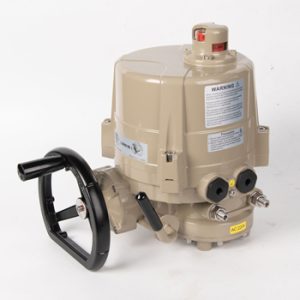

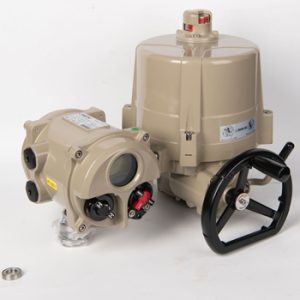
| Actuator style | ATEX electric actuator | |
| Material | Aluminum alloy | |
| Torque range | 50-20000NM | |
| Size | 50NM 80NM 100NM 150NM 200NM 300NM 500NM 600NM 800NM 1200NM 1500NM 2000NM 3000NM 4000NM 5000NM 6000NM | |
| Valve application | Butterfly valve, ball valve | |
| Actuator material | Aluminum Alloy | |
| Travel range: | 0-90° | |
| Voltage | 220VAC, 380VAC, 440VAC, 110VAC,24VDC,110VDC,220VDC | |
| Control method | Switch type, regulating type | |
| Control signal | 4-20mA, 0-10v, 1-5v | |
Electric Actuator parameters
| Model | Torque | Time | Shaft | Power | Rated Current(A) | Weight | |||
| single phase | three phases | ||||||||
| N·M | 90° | mm | W | 110V | 220V | 380V | 440V | Kg | |
| POQ-005 | 50 | 18/22 | Φ20 | 20 | 1.10/0.95 | 0.55/0.54 | 0.3/0.3 | N/A | 7.5 |
| POQ-008 | 80 | 18/22 | Φ20 | 20 | 1.10/0.95 | 0.55/0.54 | 0.3/0.3 | N/A | 7.5 |
| POQ-010 | 100 | 18/22 | Φ20 | 20 | 1.10/0.95 | 0.55/0.54 | 0.3/0.3 | N/A | 7.5 |
| POQ-015 | 150 | 21/25 | Φ20 | 40 | 1.65/1.67 | 0.88/0.84 | 0.31/0.31 | 0.30/0.31 | 17.3 |
| POQ-020 | 200 | 21/25 | Φ20 | 40 | 1.67/1.67 | 0.89/0.85 | 0.31/0.31 | 0.30/0.31 | 17.3 |
| POQ-030 | 300 | 26/31 | Φ32 | 90 | 1.85/1.86 | 0.92/0.92 | 0.35/0.35 | 0.34/0.34 | 22 |
| POQ-050 | 500 | 26/31 | Φ32 | 120 | 3.60/3.62 | 1.55/1.58 | 0.59/0.59 | 0.58/0.58 | 23 |
| POQ-060 | 600 | 26/31 | Φ32 | 120 | 3.65/3.62 | 1.60/2.20 | 0.60/0.59 | 0.59/0.58 | 23 |
| POQ-080 | 800 | 31/37 | Φ40 | 180 | 4.10/4.10 | 2.15/2.20 | 0.85/0.85 | 0.79/0.79 | 29 |
| POQ-0120 | 1200 | 31/37 | Φ40 | 180 | 4.20/4.10 | 2.35/2.30 | 0.87/0.87 | 0.81/0.81 | 29 |
| POQ-0150 | 1500 | 78/93 | Φ40 | 120 | 3.65/3.62 | 1.60/2.20 | 0.60/0.59 | 0.59/0.58 | 77 |
| POQ-0200 | 2000 | 93/112 | Φ40 | 180 | 4.10/4.10 | 2.15/2.20 | 0.85/0.85 | 0.79/0.79 | 83 |
| POQ-0300 | 3000 | 93/112 | Φ40 | 180 | 4.20/4.10 | 2.35/2.30 | 0.87/0.87 | 0.81/0.81 | 83 |
| POQ-0400 | 4000 | 155/185 | Φ40 | 180 | 4.20/4.10 | 2.35/2.30 | 0.87/0.87 | 0.81/0.81 | 83 |
| POQ-0500 | 5000 | 155/185 | Φ40 | 180 | 4.20/4.10 | 2.35/2.30 | 0.87/0.87 | 0.81/0.81 | 83 |
| POQ-0600 | 6000 | 155/185 | Φ40 | 180 | 4.20/4.10 | 2.35/2.30 | 0.87/0.87 | 0.81/0.81 | 83 |
FAQ
What does ATEX certification mean?
ATEX certification ensures that equipment complies with European Union directives for use in environments where explosive atmospheres may be present. This includes areas with risks of flammable gases, vapors, or dust. Certified equipment like these actuators is designed to operate safely in such hazardous conditions.
How do ATEX explosion-proof actuators differ from standard actuators?
ATEX explosion-proof actuators feature reinforced enclosures and components that prevent sparks or heat capable of igniting explosive substances. They are tested to stringent standards, making them significantly more reliable and safer than standard actuators when used in hazardous areas.
Are ATEX explosion-proof actuators compatible with ball valves and butterfly valves?
Yes, these actuators are specifically engineered for seamless integration with ball valves and butterfly valves. Their quarter-turn functionality makes them an excellent choice for automating these types of valves in industrial applications, especially in hazardous environments.
How do these actuators enhance the performance of ball valves and butterfly valves in hazardous environments?
ATEX explosion-proof actuators provide precise control and robust operation for ball valves and butterfly valves in settings where safety is critical. By automating valve operations, they reduce manual intervention and enable remote control, minimizing risks to personnel. Their durable construction ensures optimal valve performance even in extreme temperature, pressure, or environmental conditions.
What applications are suitable for ATEX explosion-proof actuators?
These actuators are widely used in industries such as oil and gas, chemical processing, power generation, water treatment, and mining. They are particularly suited for automating ball and butterfly valves in pipelines, storage facilities, refineries, and processing plants where exposure to explosive atmospheres is a concern.
Electric actuator catalog download
ATEX Explosion-proof? Electric actuator pdf
The post ATEX electric actuators appeared first on Control Valve Manufacturers?.
]]>Material:? Aluminum alloy
Torque range: 50-6000NM
Size:? 50NM 100NM 200NM 400NM 500NM 600NM 1000NM 2000NM 4000NM 600NM
Valve application:? Butterfly valve, ball valve
Travel range: 0-90°
Voltage: 220VAC, 380VAC, 110VAC,24VDC,110VDC,220VDC
Control signal: 4-20mA, 0-10v, 1-5v

The post Electric actuator appeared first on Control Valve Manufacturers?.
]]>Standard Features
– Quarter turn operation with mechanical limits for accurate and reliable actuation.
– Rugged Type 4X weatherproof aluminum alloy enclosure, ensuring durability in harsh environments.
– Visual valve position indicator, providing clear, real-time feedback.
– Manual override, allowing operation during power failures.
– Heavy-duty motor with overload protection, guaranteeing consistent performance under demanding conditions.
– Thermostatically controlled anti-condensation heater, preventing internal damage caused by moisture accumulation.
– Two auxiliary limit switches, confirming open and closed valve positions for enhanced system assurance.
– Self-locking all metal gear drive, eliminating the need for additional brakes and ensuring secure operation.
– Standard ISO5211 multi-flange valve mounting, simplifying installation and integration into various systems.
– Certified by CSA to rigorous UL429 and CSA C22.2 standards, with CE marking for global compliance.
Electric actuator?is specifically designed for power-to-open and power-to-close functionality, maintaining the last known position in the event of a power loss. When a continuous voltage signal is applied, the actuator’s heavy-duty motor engages, driving a robust all-metal gear system to rotate the output drive exactly 90°. Internal cams activate limit switches to automatically stop the motor, ensuring precise control. Upon receiving a reversing signal, the motor rotates in the opposite direction, reversing the drive position.
This valve actuator is commonly used to automate quarter turn ball valves, butterfly valves, or dampers and is straightforward to install using its ISO5211 multi-flange mounting and double square drive. Its unique integral motor/housing design delivers higher torque output in a compact form, making it a space-efficient solution for high-power applications.
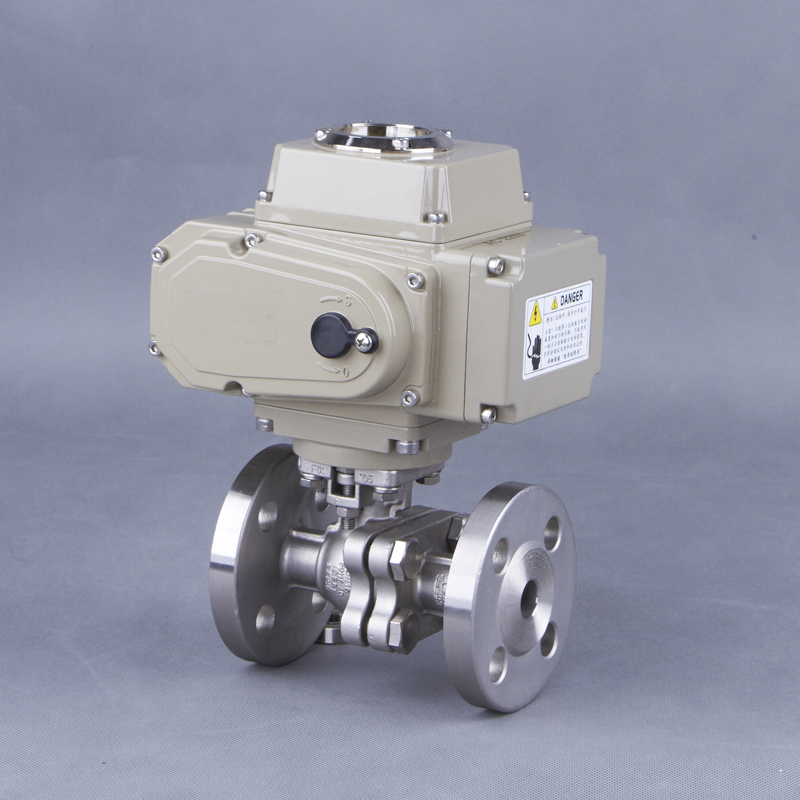
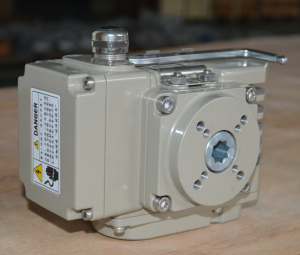
| Actuator style | Small electric actuator | |
| Material | Aluminum alloy | |
| Torque range | 50-6000NM | |
| Size | 50NM 100NM 200NM 400NM 500NM 600NM 1000NM 2000NM 4000NM 600NM | |
| Valve application | Butterfly valve, ball valve | |
| Actuator material | Aluminum Alloy | |
| Travel range: | 0-90° | |
| Voltage | 220VAC, 380VAC, 110VAC,24VDC,110VDC,220VDC | |
| Control method | Switch type, regulating type | |
| Control signal | 4-20mA, 0-10v, 1-5v | |
FAQ
What is an electric actuator?
An electric actuator is a device that uses electrical energy to control the movement of valves or dampers in industrial processes. It converts electrical signals into mechanical motion, allowing systems to operate automatically without manual intervention.
How does an electric actuator work?
Electric actuators use a motor to generate rotational or linear motion, depending on the application. For quarter-turn applications like ball or butterfly valves, the actuator rotates the valve stem 90° by driving its internal gear components. Signals from a control system tell the actuator to open, close, or modulate valve positions precisely.
What are the benefits of using electric actuators over other types?
Electric actuators offer several advantages:
– High precision and reliable control.
– Ease of integration with modern automation systems.
– Cleaner operation without the need for hydraulic fluids or air compressors.
– Low maintenance compared to pneumatic or hydraulic actuators.
– Energy-efficient functionality.
What applications are electric actuators best suited for?
Electric actuators are ideal for applications requiring precise control and automation. Common industries include:
– Chemical Processing – for accurate flow and pressure management.
– Water Treatment – for controlling valve operations in filtration and distribution systems.
– Oil and Gas – for safe handling of flow in pipelines.
– Power Generation – for managing turbines and cooling systems.
– HVAC Systems – for controlling dampers and airflow.
Electric actuator catalog download
The post Electric actuator appeared first on Control Valve Manufacturers?.
]]>Material:? Aluminum alloy
Torque range: 8-7500NM
Size:? DA32 DA40 DA52 DA63 DA75 DA83 DA92 DA100 DA105 DA125 DA140 DA160 DA190 DA210 DA240 DA270 DA300 DA350 DA400
Valve application:? Butterfly valve, ball valve
Travel range: 0-90°
Pneumatic actuator: Double acting,Single acting
Accessories: Solenoid valve, limit switch box , filter, E/P positioner, hand wheel

The post Pneumatic actuator? appeared first on Control Valve Manufacturers?.
]]>Crafted from high-grade aluminum alloy, these actuators combine exceptional strength with lightweight construction and excellent corrosion resistance, ensuring long-term reliability even in the most challenging environments. With a robust torque range of up to 7500NM
Available in double acting and single acting configurations, including normally closed and normally open options, these actuators are versatile enough to address diverse operational needs. Further enhancing their functionality, our pneumatic actuators are compatible with key components such as solenoid valves, limit switch boxes, filters, E/P positioners, and hand wheels—ensuring greater control, adaptability, and monitoring capabilities across your systems.
Whether you seek efficient flow regulation for ball valves or accurate directional control for butterfly valves, these pneumatic actuators offer an unmatched combination of flexibility, resilience, and precision.

| Actuator style | Rack and pinion | |
| Material | Aluminum alloy | |
| Torque range | 8-7500NM | |
| Size | DA32 DA40 DA52 DA63 DA75 DA83 DA92 DA100 DA105 DA125 DA140 DA160 DA190 DA210 DA240 DA270 DA300 DA350 DA400 | |
| Valve application | Butterfly valve, ball valve | |
| Actuator material | Aluminum Alloy | |
| Travel range: | 0-90° | |
| Air supply pressure | 2-8bar | |
| Pneumatic Actuator | Double acting,Single acting normally closed, acting,Single normally open | |
| Option | solenoid valve,?limit switch box?, filter, E/P positioner, hand wheel | |
FAQ
What is a pneumatic actuator?
A pneumatic actuator is a mechanical device that uses compressed air to produce motion. It is commonly used to control the movement of valves, such as pneumatic ball valves and pneumatic butterfly valves, in various industrial systems. Pneumatic actuators are valued for their reliability, efficiency, and ability to handle high-cycle operations.
How does a pneumatic actuator work?
Pneumatic actuators operate by converting the energy from compressed air into mechanical motion. When air is supplied, it fills a chamber inside the actuator, causing a piston or diaphragm to move. This movement drives the control mechanism, such as opening or closing a valve, with precision and speed. The motion can be linear or rotary, depending on the actuator design.
What are the types of pneumatic actuator?
Pneumatic actuators are typically categorized by action mode or design style. The main types include:
– Double Acting Actuators: Use compressed air for both opening and closing motions.
– Single Acting Actuators: Use compressed air for one-directional movement and rely on a spring for the return action. This can be configured as normally open or normally closed.
– Rack and Pinion Actuators: Employ a rack and pinion mechanism to achieve rotary motion, ideal for valve operations.
Pneumatic actuator catalog download
The post Pneumatic actuator? appeared first on Control Valve Manufacturers?.
]]>